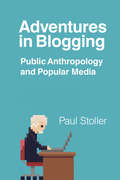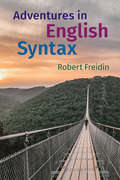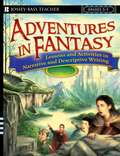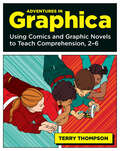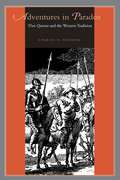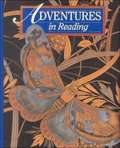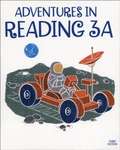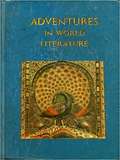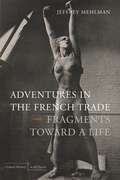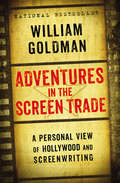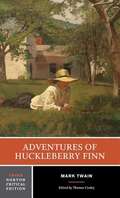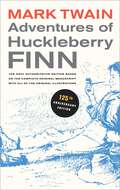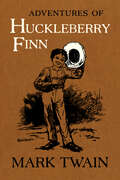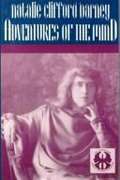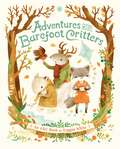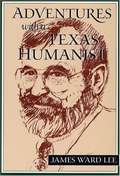- Table View
- List View
Adventures in Blogging: Public Anthropology and Popular Media
by Paul StollerPaul Stoller has been writing a popular blog for the Huffington Post since 2011. Blogging, says Stoller, allows him to bring an anthropological perspective to contemporary debates, but it also makes him a better writer: snappier, more concise, and more focused on the connection he wants to make with readers. In this collection of selected blog posts, Stoller models good writing while sharing his insights on politics (including the emergence of "Trumpism" and the impact of ignorance on US political practices), higher education, social science, media, and well-being. In the process, he discusses the changing nature of scholarly communication and the academy’s need for greater public engagement.
Adventures in English Syntax
by Robert FreidinFor anyone who wants to become a more effective writer, a more perceptive reader, and a more precise thinker, an understanding of English sentence structure is indispensable. This book shows you how to begin. Using clear and engaging examples from English, it introduces the basic concepts of syntactic structure to readers with no background in linguistics. Starting with simple, familiar phrases, and progressing to more complex sentences, it builds on what we already intuitively know, to provide a step-by-step account of why we understand these examples as we do. It then shows how that understanding can be applied to writing, helping us to avoid some of the common hallmarks of 'bad writing', such as ambiguity, redundancy, and vagueness. A unique and valuable resource, this book will enrich your understanding of English in ways that will make you a more effective user of the language.
Adventures in Fantasy
by John GustAdventures in Fantasy offers an exciting approach to teaching narrative and descriptive writing that stimulates a student's creativity and imagination. Filled with mini-lessons, reading projects, and hands-on writing activities, the book shows teachers step-by-step how to introduce students to the "magic" of creating a complete story in the fantasy/adventure genre. Before fleshing out their stories, however, students are asked to construct actual maps of their 'fantasyland' - and then to write a travelogue describing the setting in vivid detail. This initial fantasizing encourages students to be wildly inventive in creating the drama, ogres, villains, heroes and heroines featured in their story, and on the way they learn about the mythic journey.
Adventures in Graphica: Using Comics and Graphic Novels to Teach Comprehension, 2-6
by Terry ThompsonGraphica is a medium of literature that integrates pictures and words and arranges them to tell a story or convey information, usually presented in a comic strip, periodical, or book form AKA comics. It's no surprise comics have long been popular with kids and adults; some of our greatest heroes were introduced to us in comic form. Drawing on his own success using graphica with elementary students, literacy coach Terry Thompson introduces reading teachers to this popular medium in Adventures in Graphica: Using Comics and Graphic Novels to Teach Comprehension, Grades 2-6. In his book, Thompson explains how graphica can be an engaging and motivating tool for reluctant readers who often shun traditional texts. He suggests sources of appropriate graphica for the classroom and demonstrates how to fit this medium into the literacy framework and correlates with best practices in comprehension, vocabulary, and fluency instruction.Adventures in Graphica contains numerous, easy-to-replicate, instructional strategies, including examples of how graphic texts can be used to create a bridge and students transfer abstract comprehension strategies learned through comics and graphic novels to traditional texts. It is an excellent roadmap for teachers looking to add graphica to their classrooms.
Adventures in Paradox: Don Quixote and the Western Tradition (Studies in Romance Literatures)
by Charles D. PresbergCervantes’s Don Quixote confronts us with a series of enigmas that, over the centuries, have divided even its most expert readers: Does the text pursue a serious or comic purpose? Does it promote the truth of history and the untruth of fiction, or the truth of poetry and the fictiveness of truth itself? In a book that will revise the way we read and debate Don Quixote, Charles D. Presberg discusses the trope of paradox as a governing rhetorical strategy in this most canonical of Spanish literary texts. To situate Cervantes’s masterpiece within the centuries-long praxis of paradoxical discourse in the West, Presberg surveys its tradition in Classical Antiquity, the Middle Ages, and the European Renaissance. He outlines the development of paradoxy in the Spanish Renaissance, centering on works by Fernando de Rojas, Pero Mexía, and Antonio de Guevara. In his detailed reading of portions of Don Quixote, Presberg shows how Cervantes’s work enlarges the tradition of paradoxical discourse by imitating as well as transforming fictional and nonfictional models. He concludes that Cervantes’s seriocomic "system" of paradoxy jointly parodies, celebrates, and urges us to ponder the agency of discourse in the continued refashioning of knowledge, history, culture, and personal identity.This engaging book will be welcomed by literary scholars, Hispanisists, historians, and students of the history of rhetoric and poetics.
Adventures in Reading (Pegasus Edition)
by Fannie Safier Margaret Ferry Wanda SchindleyLiterature textbook.
Adventures in Reading 3A (Third Edition)
by Bju PressCarefully selected third-grade-leveled reading selections will help students improve their reading skills through progressively difficult texts. An element of the BJU Press Reading Grade 3 Curriculum, this is the first of two readers. Divided into two sections - - - "Actions & Attitudes" and "Missions and Memories" - - - each features multiple stories in different genres such as poetry, realistic fiction, biographies, and historical fiction. Feature pages include "think and discuss" and "look again" questions that highlight literary skills, comprehension questions, and vocabulary. Different artistic styles are used for the illustrations. 385 pages, softcover with glossary, 3rd Edition.
Adventures in Reading 3B (Third Edition)
by Kathleen Hynicka Amy Schoneweis Robin E. ScrogginsThe book contains developmentally appropriate selections from a variety of genres with a progression of difficulty in readability and skills to provide success for every student. New Bible retellings closely follow the text in Scripture.
Adventures in Reading: Athena Edition
by Holt Rinehart WinstonStories can be found anywhere and everywhere. Think of the number of different stories that might be inspired by the painting shown on these pages. Examine the painting closely. Use your imagination to write a story. Some of the following suggestions may help you free-write your first thoughts.
Adventures in World Literature Classic Edition
by Gordon Browne James Applegate Gretchen C. Hankins Thomas M. Folds M. Elinor Brown"World Literature textbook for High School students
Adventures in the French Trade: Fragments Toward a Life
by Jeffrey MehlmanMehlman (French literature, Boston University) deconstructs and recreates his intellectual and, at times, personal life in this freewheeling memoir. His fascination with French authors and literary theorists, such as Derrida, Mauron and Lacan, along with a desire to understand the love/hate relationship of Jewish intellectuals with France are recurrent riffs in the story. However, Mehlman's memories skip about, as they do in reality, one recalling another, leaping back and forth in time, occasionally repeating themselves in slightly different ways. It does not surprise that Mehlman is a devotée of Proust. The memories are compelling in themselves. One doesn't need to have read Mehlman's other works to enjoy his ramblings through life. It does help if one is a Francophile with a sense of humor. Annotation ©2011 Book News, Inc. , Portland, OR (booknews. com)
Adventures in the Screen Trade
by William GoldmanNow available as an ebook for the first time!No one knows the writer's Hollywood more intimately than William Goldman. Two-time Academy Award-winning screenwriter and the bestselling author of Marathon Man, Tinsel, Boys and Girls Together, and other novels, Goldman now takes you into Hollywood's inner sanctums...on and behind the scenes for Butch Cassidy and the Sundance Kid, All the President's Men, and other films...into the plush offices of Hollywood producers...into the working lives of acting greats such as Redford, Olivier, Newman, and Hoffman...and into his own professional experiences and creative thought processes in the crafting of screenplays. You get a firsthand look at why and how films get made and what elements make a good screenplay. Says columnist Liz Smith, "You'll be fascinated.
Adventures of Don Quixote (Amplify Core Knowledge Language Arts Activity Book)
by Amplify LearningUnit 4 is centered around an adapted version of Don Quixote paired with Miguel de Cervantes's Adventures of Don Quixote.
Adventures of Don Quixote: Activity Book (Amplify Core Knowledge Language Arts, Grade 5 #Unit 4)
by Amplify EducationNIMAC-sourced textbook
Adventures of Huckleberry Finn (Norton Critical Editions)
by Mark TwainThis perennially popular Norton Critical Edition reprints for the first time the definitive Iowa-California text of Adventures of Huckleberry Finn, complete with all original illustrations by Edward Windsor Kemble and John Harley. The text is accompanied by explanatory annotations. <p><p> "Contexts and Sources" provides readers with a rich selection of documents related to the historical background, language, composition, sale, reception, and newly discovered first half of the manuscript of Mark Twain's greatest work. Included are letters on the writing of the novel, excerpts from the author's autobiography, samples of bad poetry that inspired his satire (including an effort by young Sam Clemens himself), a section on the censorship of Adventures of Huckleberry Finn by schools and libraries over a hundred-year period, and commentary by David Carkeet on dialects of the book and by Earl F. Briden on its "racist" illustrations. In addition, this section reprints the full texts of both "Sociable Jimmy," upon which is based the controversial theory that Huck speaks in a "black voice," and "A True Story, Repeated Word for Word As I Heard It," the first significant attempt by Mark Twain to capture the speech of an African American in print. <p> "Criticism" of Adventures of Huckleberry Finn is divided into "Early Responses" (including the first negative review) and "Modern Views" by Victor A. Doyno, T. S. Eliot, Jane Smiley, David L. Smith, Shelley Fisher Fishkin (the "black voice" thesis), James R. Kincaid (a rebuttal of Fishkin), and David R. Sewell. Also included is Toni Morrison's moving personal "Introduction" to the troubling experience of reading and re-reading Mark Twain's masterpiece.
Adventures of Huckleberry Finn, 125th Anniversary Edition: The only authoritative text based on the complete, original manuscript (Mark Twain Library #9)
by Mark TwainThis 125th Anniversary edition of Adventures of Huckleberry Finn is expanded with updated notes and references and a selection of original documents—letters, advertisements, playbills—some never before published, from Twain's first "book tour" to promote its original publication. This is the only edition of Twain's masterpiece based on his complete manuscript, including the 663 pages found in a Los Angeles attic in 1990. It includes all of the illustrations commissioned by Mark Twain, historical notes, a glossary, maps, and selected manuscripts.
Adventures of Huckleberry Finn: The Authoritative Text with Original Illustrations (Mark Twain Library #9)
by Mark TwainA beautiful hardcover repackaging of this timeless classic from the publishers of the Autobiography of Mark Twain and in partnership with the Mark Twain Project. This definitive edition of Adventures of Huckleberry Finn was the only version of Mark Twain’s masterpiece based on his complete manuscript, including the 663 pages found in a Los Angeles attic in 1990. Prepared by the Mark Twain Papers, the official archive of Sam Clemens’s papers at the University of California, Berkeley, this volume features the gorgeous original illustrations that Twain commissioned from Edward Windsor Kemble and John Harley and also includes historical notes, a glossary, maps, selected manuscript pages, and even a gallery of letters, advertisements, and playbills from Twain’s first "book tour" to promote the original publication—everything the discerning reader needs to enjoy this classic of American literature again and again.
Adventures of a Verbivore
by Richard LedererLed by a self-proclaimed verbivore--someone who makes a daily diet of words--this journey through the marvels and complexities of the English language celebrates oxymorons, confusables, and anagrams.
Adventures of the Mind: The Memoirs of Natalie Clifford Barney
by Natalie C. Barney John S. GattonBarney explores her family tree, chronicles her friendships and associations through reprinted correspondence and recreated conversations, and evokes the golden age of her salon in gallery of literary portraits.
Adventures of the Superkids, Reader
by Pleasant T. Rowland Loretta Lustig Meryl Henderson Doug RoySuperkids have been helping students enjoy reading for years. This reader provides students opportunities to practice core skills.
Adventures with Barefoot Critters
by Teagan WhiteFans of the adorable characters in The Quiet Book will love this seasonal romp through the alphabet. Will have definite trade and gift appeal due to Teagan White's sweet anthropomorphic critters. Join an adorable cast of animal characters as they explore the alphabet through the seasons. From gathering honey in spring to building cozy campfires in fall, the friends make the most of each season, both enjoying the great outdoors and staying snug inside. Learning the alphabet is fun when adventuring with these critters, and children and adults alike will delight in Teagan White's sweet, nostalgic illustrations.
Adventures with a Texas Humanist
by James Ward LeeIn the first two essays in this volume--"The Age of Dobie" and "The Age of McMurtry"--James Ward Lee places the writers, the politicians, and the cultural leaders in the context of each age. Subsequent chapters discuss writers and trends in Texas literature. Lee discusses long-standing arguments about Texas literature and surveys bodies of work that have had an impact on it.
